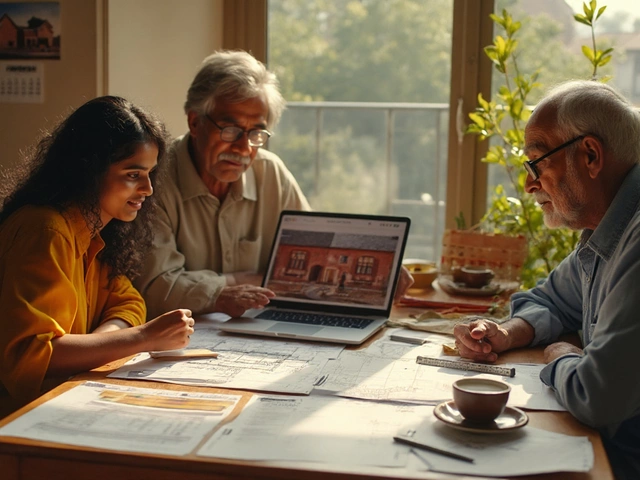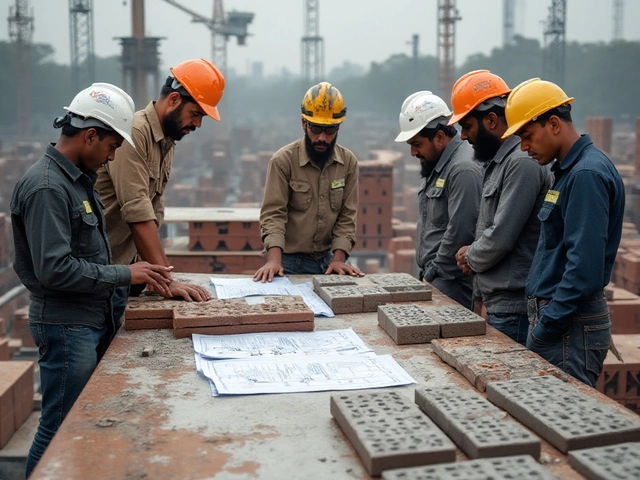Full Architectural Service: What It Really Means for Your Project
Think an architect just hands you a set of blueprints and calls it a day? Not even close. Full architectural service takes you from your wildest design ideas all the way to moving in. There’s way more going on behind the scenes than most people realize.
You might be surprised to learn that over 80% of the architect’s time on a typical house goes to planning, paperwork, and making sure your project survives city approval—stuff that happens long before a single wall goes up. But that’s also how you avoid mistakes, torn-up schedules, and budget blowouts.
If you’ve ever wondered who deals with the council when your design needs a permit, who negotiates with builders, or how those fancy 3D drawings actually turn into real walls, you’re in the right spot. Full service means someone’s got your back the whole way—not just until the ink dries on your plans.
- Defining Full Architectural Service
- Key Stages from Start to Finish
- What Architects Actually Do
- Costs and Contracts Explained
- When You Need Full Service (and When You Don’t)
- Tips for Working With Your Architect
Defining Full Architectural Service
So, what actually falls under a full architectural service? It’s basically an A-to-Z package where an architect is hands-on from your first chat to the last day on site. People often think hiring an architect stops at getting drawings, but the real value is everything else that comes after.
Full service means the architect doesn’t just design the building. They handle council approvals, details for builders, and all the complicated stuff you’d probably never want to manage. They’re in your corner for each decision and every hurdle, whether you’re picking out windows, sorting fire safety, or dealing with random issues during the build.
Want to see which tasks are usually covered? Here’s a typical breakdown:
- Initial design meetings and listening to what you want
- Site research and measuring
- Concept and detailed designs
- Getting planning permissions sorted
- Construction drawings and technical details
- Consulting with engineers and specialists
- Helping pick materials and finishes
- Overseeing bidding and tendering for builders
- Visiting the site to check on work progress
- Problem-solving if things go sideways on site
If you’re curious how involved architects are, check this out:
| Stage | % of Architect's Time |
|---|---|
| Concept & Design | 20% |
| Drawings & Technical Docs | 30% |
| Approvals & Permits | 15% |
| Construction Oversight | 25% |
| Project Admin & Support | 10% |
This isn’t just about making something look cool—full service ties all the moving parts together. When you’ve got your architect involved from day one, they spot issues early, find smart ways to cut costs, and make sure standards and regulations don’t trip you up down the road. That’s why people who pay for full service usually avoid expensive surprises.
Key Stages from Start to Finish
A full architectural service isn’t just one meeting and a handful of drawings—it’s a structured process that keeps your project on track and saves money over the long run. Here’s how it generally plays out, whether you’re building your dream home or a brand-new office.
- Feasibility and Pre-Design: This is where the architect asks questions, listens to your needs, checks the site, and reviews local regulations. It’s not flashy, but this groundwork shapes the whole project. They’ll also advise if your dream matches reality—think budget, zoning, and any ‘hidden traps’ on your property.
- Concept Design: Now things get visual. Architects sketch possibilities, come up with layouts, and help you decide what’s possible. These early drawings might seem rough, but they help you imagine real spaces and fix obvious problems before anything expensive happens.
- Design Development: With your feedback, architects flesh out the concept into detailed plans. Here, they start specifying materials, energy efficiency ideas, and room dimensions. This is where your project starts looking like the one you pictured in your head.
- Planning and Permits: Some of the least exciting but most critical work happens here. Submitting plans to the city, handling regulations, heritage approvals, and negotiating changes–it’s all on your architect. This stage can take weeks or even months, depending on the location.
- Construction Documents: These are detailed blueprints and specs that the contractors use to price and build the project. Mistakes here can cost a fortune down the line, so your architect makes sure every detail is clear—windows, wiring, materials, the lot.
- Bidding and Contractor Selection: Your architect helps you compare bids, spot red flags, and choose the right builder, not just the cheapest one. It’s a step a lot of people try to skip—usually at their own risk.
- Construction Administration: During the actual build, the architect checks in, answers technical questions, inspects work, and keeps things moving. If the builder tries to cut corners or runs into a snag, the architect steps in to protect your vision and your money.
A true full architectural service covers you from that first coffee meeting until the keys are in your hand. This step-by-step approach keeps surprises to a minimum and cuts down on stress for everyone involved.
What Architects Actually Do
When people picture an architect, they usually see someone hunched over a desk sketching a cool house, but that’s just the tip of the iceberg. A big part of full architectural service is project management, technical problem-solving, and making sure every little rule is followed.
Architects spend a shocking amount of time on the stuff that keeps your project legal and buildable. For example, on a typical project, only about 20-30% of their effort actually goes into drawing and designing; the rest is spent handling paperwork and coordination. Here’s what they usually tackle:
- Design – from concept sketches to the final look, including floor plans, 3D renders, and choosing finishes.
- Planning approvals – dealing with zoning rules, filling out permit applications, and hanging in there through local government delays.
- Technical drawings – these are super detailed blueprints that builders use. They show everything: where the wiring goes, how to build the roof, and even what insulation to use.
- Finding contractors – architects can help you bid your project out to builders, check their quotes, and make sure you don’t get ripped off.
- Site visits and supervision – they visit the site to spot mistakes early, answer questions from builders, and keep you in the loop if anything goes sideways.
- Budget management and value engineering – balancing what you want with what you can actually afford, and suggesting smart material swaps if prices jump.
Here’s a quick look at how their time usually breaks down during a full architectural service:
| Task | Average % of Time Spent |
|---|---|
| Design & Drawings | 25% |
| Permits & Regulations | 20% |
| Project Coordination | 25% |
| Site Supervision | 15% |
| Budget & Contract Management | 15% |
Architects are also the ones who translate your random Pinterest board into something builders can actually make. They sort out things like local building codes (did you know rules can change block by block?), get engineers on board when needed, and help you avoid rookie mistakes—like putting a window right where your neighbor’s privacy fence will block all the light.
If problems pop up during the build, your architect is the one fielding panicked phone calls and sorting out solutions before they snowball into expensive disasters. They’re the go-between for you, your builders, and the city inspectors, making sure the dream you started with is what you end up living in.

Costs and Contracts Explained
You’re going to hear all sorts of things about how architects charge for full architectural service. Some folks expect a flat rate, others think it’s a mystery fee. Here’s the real deal: most architects either work on a percentage of your total build costs (usually between 6% and 12%), an hourly rate, or a fixed lump sum. The percentage system is super common for custom homes and big remodeling jobs.
Let’s break that down with an example. If you’re building a house for $400,000 and your architect charges 8%, that’s $32,000 for their services—spread across the whole project, start to finish. This pays for everything from first meetings and sketching to showing up on the site and checking the builders’ work. Some smaller jobs may get billed hourly, but big ones usually bring out the percentage or fixed-fee contract.
| Fee Type | How It Works | Typical Range |
|---|---|---|
| Percentage of construction | Fee based on total build cost | 6%–12% |
| Hourly rate | Billed for actual time spent | $100–$250/hour |
| Fixed fee | Set price for specific project scope | Varies by job size |
Make sure you see exactly what’s included when you sign a contract. Does the fee cover visits to the site while builders are working? Are submission costs for permits extra? Any study published by the AIA (American Institute of Architects) will tell you: hidden costs and unclear contracts are the top reasons people argue with their architects.
- Ask for a breakdown of phases (design, approvals, construction help) in your contract.
- Find out if estimates include project management or just drawings.
- Clarify what happens if you want design changes halfway through.
- Agree on a schedule for payments—most jobs have milestones, not one big bill upfront.
One handy tip: if cash is tight, ask if you can pick and choose which steps you want your architect involved in. Some people skip site visits or finish work without full service, but be careful because mistakes can cost more than you save.
When You Need Full Service (and When You Don’t)
Not every project actually calls for a full architectural service. Sometimes, you’re paying for a whole package when you only need a slice of the pie. So how do you decide?
If your building or renovation is complex—think big additions, new homes, special permits, heritage sites, or tricky city lots—you’ll usually need the full deal. Full service means the architect handles everything: design, permits, working with engineers, managing contractors, and answering every curveball that pops up. For a custom house or anything in a dense urban area, this level of help isn’t just nice—it’s almost a must. Research from the Royal Institute of British Architects shows that complex projects with full architect involvement hit fewer roadblocks and come in closer to budget.
But what if you’re swapping out kitchen cabinets or adding a deck? You probably don’t need that kind of hand-holding. Many architects offer limited services, like just drawing plans for you to submit, or giving expert advice on layout. If your project is simple and you have a competent contractor, cutting down the architect’s role can save a chunk of money and time.
- Go full service when you: have design goals that matter, face tricky rules, need permits, or want someone to wrangle the builders.
- Go minimal when: your project is basic, and you’re comfortable dealing with contractors, permits, and surprises yourself.
One experienced architect said it best:
“If you want peace of mind and a smooth process from ideas to moving in, full service is worth every penny. If you love project-managing and don’t mind headaches, save your cash—but know what you’re signing up for.”
Knowing when to splurge on full service (and when to skip it) can save you from a world of regrets—and unexpected bills.
Tips for Working With Your Architect
Getting the most out of your architect means knowing how to share your ideas and what kind of decisions you’ve got to make. You don’t need to talk in fancy design lingo—a good architect listens and translates your wish list into something that actually works. Still, a little know-how on your part helps the whole process go smoother.
- Be clear about your goals. Write down your “must-haves” and “nice-to-haves” before your first meeting. This saves time and keeps everyone on the same page.
- Share your budget up front. Hiding your real number just leads to designs you can’t afford.
- Meet regularly. A weekly or bi-weekly check-in (even just a 15-minute call) keeps things moving and clears up misunderstandings early.
- Ask for sketches or 3D models. These are way easier to understand than technical plans if you’re not used to reading blueprints.
- Review what you’re signing. Contracts, fee proposals, and any extras should all be in plain English. If you don’t get it, ask your architect to explain.
- Don’t be shy about feedback. If something feels off or doesn’t reflect your ideas, speak up. It’s easier (and cheaper) to fix things on paper than during construction.
Most folks don’t realize that architects spend about 25% of their project time just communicating with clients and builders—that’s more than drawing or modeling. Good communication cuts down on mistakes, schedule slip-ups, and surprise bills.
Here’s a quick look at where architects generally spend their time during a full architectural service:
| Task | Average Time Spent (%) |
|---|---|
| Client Communication & Meetings | 25% |
| Design & Drawings | 30% |
| Regulatory Approvals | 20% |
| Construction Oversight | 15% |
| Tendering/Contract Work | 10% |
If you want your project to run smoothly, treat your architect like a teammate, not just a service provider. Open chats, quick decisions, and clear feedback can save you weeks—or sometimes thousands of dollars. In other words, don’t go silent and don’t just say “yes” to everything.







Comments